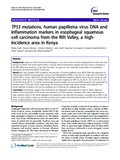| dc.description.abstract | BACKGROUND:
Squamous Cell Carcinoma of Esophagus is one of the most common malignancies in both men and women in eastern and south-eastern Africa. In Kenya, clinical observations suggest that this cancer is frequent in the Rift Valley area. However, so far, there has been no report on the molecular characteristics of esophageal squamous cell carcinoma (ESCC) in this area.
RESULTS:
We have analyzed TP53 mutations, the presence of human papilloma virus (HPV) DNA and expression of inflammation markers Cyclooxygenase 2 (Cox-2) and Nitrotyrosine (NTyR) in 28 cases (13 males and 15 females) of archived ESCC tissues collected at the Moi Teaching and Referral Hospital in Eldoret, Kenya. Eleven mutations were detected in TP53 exons 5 to 8 (39%). All ESCC samples were negative for HPV 16, 18, 26, 31, 33, 35, 39, 45, 51, 52, 53, 56, 58, 59, 66, 68, 70, 73 and 82. Immunohistochemical analysis of Cox-2 and NTyR showed a low proportion of positive cases (17.4% and 39.1%, respectively). No association between the above markers and suspected risk factors (alcohol or tobacco use, hot tea drinking, use of charcoal for cooking) was found.
CONCLUSION:
Our findings suggest that mechanisms of esophageal carcinogenesis in eastern Africa might be different from other parts of the world. Low prevalence of TP53 mutation compared with other intermediate or high incidence areas of the world highlights this hypothesis. Our data did not support a possible ole of HPV in this series of cases. Further studies are needed to assess and compare the molecular patterns of ESCC from Kenya with those of high-incidence areas such as China or Central Asia. | en |


